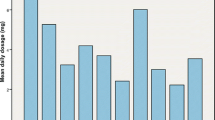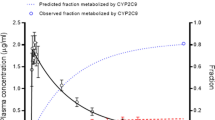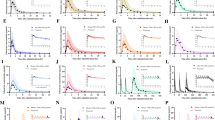Abstract
Warfarin therapy is complicated by its large inter-individual and intra-individual variability. Both genetic and non-genetic factors can affect warfarin therapy. This study aims to investigate the allele distribution of VKORC1, CYP2C9 and CYP2C19, contribution of different allele variants and possible gene–gene interaction on warfarin therapy. Four hundreds and ninety-two patients were enrolled and single nucleotide polymorphisms for vitamin K epoxide reductase complex subunit 1 (VKORC1), cytochrome P450 CYP2C9 and cytochrome P450 CYP2C19 were genotyped. CYP2C9*1 allele is in complete linkage disequilibrium with CYP2C19*2 and CYP2C19*17 (D′ = 1) in our study population. Patient with VKORC1-1639 G > A, CYP2C9*2 and CYP2C9*3 genetic variants need significant lower warfarin dose than patient with wild type allele of VKORC1 1639 G or CYP2C9*1. There is no significant differences between CYP2C19 allele variants for warfarin stable dose and INR > 5 event. Because of the complete linkage disequilibrium between CYP2C19*2,*17 and CYP2C9*1, patient with CYP2C19 *2/*2, *2/*17 and *17/*17 genotypes tend to have higher warfarin dose than patient with CYP2C19*1/*1 genotype. Stepwise regression analysis showed that VKORC1, CYP2C9, body mass index (BMI), age and gender were included as a factor significantly contributing to warfarin dose, whereas CYP2C19 did not contribute to warfarin dose. No statistically significant interaction between CYP2C9 and VKORC1 on warfarin dose and INR > 5 event was detected in univariate general linear model analysis. Our study suggests that polymorphic variants of VKORC1 and CYP2C9 affect warfarin dose independently, whereas CYP2C19 did not contribute to warfarin therapy.
Similar content being viewed by others
References
Flockhart DA, O’Kane D, Williams MS, Watson MS, Flockhart DA, Gage B, Gandolfi R, King R, Lyon E, Nussbaum R, O’Kane D, Schulman K, Veenstra D, Williams MS, Watson MS (2008) ACMG Working Group on Pharmacogenetic testing of CYP2C9 and VKORC1 alleles for warfarin. Genet Med 10(2):139–150
Yuan HY, Chen JJ, Lee MT, Wung JC, Chen YF, Charng MJ, Lu MJ, Hung CR, Wei CY, Chen CH, Wu JY, Chen YT (2005) A novel functional VKORC1 promoter polymorphism is associated with inter-individual and inter-ethnic differences in warfarin sensitivity. Hum Mol Genet 14(13):1745–1751
Rettie AE, Korzekwa KR, Kunze KL, Lawrence RF, Eddy AC, Aoyama T, Gelboin HV, Gonzalez FJ, Trager WF (1992) Hydroxylation of warfarin by human cDNA-expressed cytochrome P-450: a role for P-4502C9 in the etiology of (S)-warfarin-drug interactions. Chem Res Toxicol 5(1):54–59
Aithal GP, Day CP, Kesteven PJ, Daly AK (1999) Association of polymorphisms in the cytochrome P450 CYP2C9 with warfarin dose requirement and risk of bleeding complications. Lancet 353(9154):717–719
Li X, Liu R, Yan H, Tang J, Yin JY, Mao XY, Yang F, Luo ZY, Tan SL, He H, Chen XP, Liu ZQ, Li Z, Zhou HH, Zhang W (2015) Effect of CYP2C9-VKORC1 interaction on warfarin stable dosage and its predictive algorithm. J Clin Pharmacol 55(3):251–257
Schalekamp T, Brassé BP, Roijers JF, van Meegen E, van der Meer FJ, van Wijk EM, Egberts AC, de Boer A (2007) VKORC1 and CYP2C9 genotypes and phenprocoumon anticoagulation status: interaction between both genotypes affects dose requirement. Clin Pharmacol Ther 81(2):185–193
Schalekamp T, Brassé BP, Roijers JF, Chahid Y, van Geest-Daalderop JH, de Vries-Goldschmeding H, van Wijk EM, Egberts AC, de Boer A (2006) VKORC1 and CYP2C9 genotypes and acenocoumarol anticoagulation status: interaction between both genotypes affects overanticoagulation. Clin Pharmacol Ther 80(1):13–22
van Schie RM, Babajeff AM, Schalekamp T, Wessels JA, le Cessie S, de Boer A, van der Meer FJ, van Meegen E, Verhoef TI, Rosendaal FR, Maitland-van der Zee AH (2012) EU-PACT study group. An evaluation of gene–gene interaction between the CYP2C9 and VKORC1 genotypes affecting the anticoagulant effect of phenprocoumon and acenocoumarol. J Thromb Haemost 10(5):767–772
Chang M, Söderberg MM, Scordo MG, Tybring G, Dahl ML (2015) CYP2C19*17 affects R-warfarin plasma clearance and warfarin INR/dose ratio in patients on stable warfarin maintenance therapy. Eur J Clin Pharmacol 71(4):433–439
Scordo MG, Pengo V, Spina E, Dahl ML, Gusella M, Padrini R (2002) Influence of CYP2C9 and CYP2C19 genetic polymorphisms on warfarin maintenance dose and metabolic clearance. Clin Pharmacol Ther 72(6):702–710
Uno T, Sugimoto K, Sugawara K, Tateishi T (2008) The effect of CYP2C19 genotypes on the pharmacokinetics of warfarin enantiomers. J Clin Pharm Ther 33(1):67–73
Rusdiana T, Araki T, Nakamura T, Subarnas A, Yamamoto K (2013) Responsiveness to low-dose warfarin associated with genetic variants of VKORC1, CYP2C9, CYP2C19, and CYP4F2 in an Indonesian population. Eur J Clin Pharmacol 69(3):395–405
Gaunt TR, Rodríguez S, Day IN (2007) Cubicexact solutions for the estimation of pairwise haplotype frequencies: implications for linkage disequilibrium analyses and a webtool ‘CubeX’. BMC Bioinformatics 8:428
Lee CR, Goldstein JA, Pieper JA (2002) Cytochrome P450 2C9 polymorphisms: a comprehensive review of the in vitro and human data. Pharmacogenetics 12(3):251–263
Baldwin RM, Ohlsson S, Pedersen RS, Mwinyi J, Ingelman-Sundberg M, Eliasson E, Bertilsson L (2008) Increased omeprazole metabolism in carriers of the CYP2C19*17 allele; a pharmacokinetic study in healthy volunteers. Br J Clin Pharmacol 65(5):767–774
Pedersen RS, Brasch-Andersen C, Sim SC, Bergmann TK, Halling J, Petersen MS, Weihe P, Edvardsen H, Kristensen VN, Brøsen K, Ingelman-Sundberg M (2010) Linkage disequilibrium between the CYP2C19*17 allele and wildtypeCYP2C8 and CYP2C9 alleles: identification of CYP2C haplotypes in healthy Nordic populations. Eur J Clin Pharmacol 66(12):1199–1205
Hulot JS, Bura A, Villard E, Azizi M, Remones V, Goyenvalle C, Aiach M, Lechat P, Gaussem P (2006) Cytochrome P450 2C19 loss-of-function polymorphism is a major determinant of clopidogrel responsiveness in healthy subjects. Blood 108(7):2244–2247
Kim SY, Kang JY, Hartman JH, Park SH, Jones DR, Yun CH, Boysen G, Miller GP (2012) Metabolism of R- and S-warfarin by CYP2C19 into four hydroxywarfarins. Drug Metab Lett 6(3):157–164
Nastasi-Catanese JA, Padilla-Gutiérrez JR, Valle Y, Ortega-Gutiérrez F, Gallegos-Arreola MP, Figuera LE (2013) Genetic contribution of CYP2C9, CYP2C19, and APOE variants in acenocoumarol response. Genet Mol Res 12(4):4413–4421
Lee S, Hwang HJ, Kim JM, Chung CS, Kim JH (2007) CYP2C19 polymorphism in Korean patients on warfarin therapy. Arch Pharm Res 30(3):344–349
Shuldiner AR, O’Connell JR, Bliden KP, Gandhi A, Ryan K, Horenstein RB, Damcott CM, Pakyz R, Tantry US, Gibson, Pollin TI, Post W, Parsa A, Mitchell BD, Faraday N, Herzog W, Gurbel PA (2009) Association of cytochrome P450 2C19 genotype with the anti-platelet effect and clinical efficacy of clopidogrel therapy. JAMA 302(8):849–857
Sibbing D, Koch W, Gebhard D, Schuster T, Braun S, Stegherr J, Morath T, Schömig A, von Beckerath N, Kastrati A (2010) Cytochrome 2C19*17 allelic variant, platelet aggregation, bleeding events, and stent thrombosis in clopidogrel-treated patients with coronary stent placement. Circulation 121(4):512–518
Acknowledgments
We would like to thank Dr. David Livert for helpful comments on the manuscript.
Author information
Authors and Affiliations
Corresponding author
Rights and permissions
About this article
Cite this article
Khalighi, K., Cheng, G., Mirabbasi, S. et al. Linkage disequilibrium between the CYP2C19*2,*17 and CYP2C9*1 alleles and impact of VKORC1, CYP2C9, CYP2C19 gene polymorphisms and gene–gene interactions on warfarin therapy . J Thromb Thrombolysis 43, 124–129 (2017). https://doi.org/10.1007/s11239-016-1436-2
Published:
Issue Date:
DOI: https://doi.org/10.1007/s11239-016-1436-2




